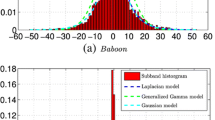Abstract
We have presented a new active steganalysis method in order to break the block-discrete cosine transform (DCT) coefficients steganography. Our method is based on a combination of the Blind Source Separation (BSS) technique and Maximum A posteriori (MAP) estimator. We have additionally introduced a new geometrical BSS method based on the minimum range of mixed sources which reduces the computational cost of the proposed steganalysis. The high efficiency of this new combined method has been confirmed by enough experiments. These experiments show that, compared to the previous active steganalysis methods our active steganalysis method not only reduces the error rate but also causes a low computational cost.








Similar content being viewed by others
References
Abate JE (1967) Linear and adaptive delta modulation. Proc IEEE 55:298–308
Ambalavanan A, Chandramouli R (2007) Blind source separation for steganalytic secret message estimation. Proc SPIE. p 650507
Avcibas I, Memon N, Sankur B (2003) Steganalysis using image quality metrics. Image Process IEEE Trans On 12:221–229
Azzabou N, Paragios N, Guichard F (2007) Uniform and textured regions separation in natural images towards MPM adaptive denoising. Scale Space Var Methods Comput Vis 418–429
Babaie-Zadeh M, Jutten C, Nayebi K (2002) A geometric approach for separating post non-linear mixtures. Proc XI Eur. Signal Process. Conf. EUSIPCO 2002. pp 11–14.
Chandramouli R (2003) A mathematical framework for active steganalysis. Multimed Syst 9:303–311
Crouse MS, Nowak RD, Baraniuk RG (1998) Wavelet-based statistical signal processing using hidden Markov models. Signal Process IEEE Trans On 46:886–902
Fan F, Jiazhen W, Xiaoqin L, Huijuan F (2007) An Active Steganalysis Method of Block-DCT Image Information Hiding. Electron Meas Instrum. 2007 ICEMI07 8th Int Conf On. pp 2–849
Fridrich J, Kodovskỳ J (2013) Steganalysis of LSB replacement using parity-aware features. Inf Hiding pp 31–45
Harmsen JJ, Pearlman WA (2003) Steganalysis of additive-noise modelable information hiding. Proc SPIE pp 131–142
Hyvarinen A (1999) Fast and robust fixed-point algorithms for independent component analysis. Neural Netw IEEE Trans On 10:626–634
Hyvrinen A, Karhunen J, Oja E (2001) Independent component analysis. John Willey Sons
Johnson NF, Jajodia S (1998) Steganalysis of images created using current steganography software. Inf. Hiding. pp 273–289
Johnson NF, Jajodia S (1998) Steganalysis: the investigation of hidden information. Inf Technol Conf IEEE pp 113–116
Jutten C, Jutten Zadeh M (2006) Source separation: principles, current advances and applications. IAR Annu Meet Nancy Fr 1–10
Lyu S, Farid H (2006) Steganalysis using higher-order image statistics. Inf Forensic Secur IEEE Trans On 1:111–119
MATLAB - The language of technical computing - math works. http://www.mathworks.com/products/matlab/. Accessed 10 Dec 2013
Nissar A, Mir A (2010) Classification of steganalysis techniques: a study. Digit Signal Process 20:1758–1770
Papoulis A, Probability RV (1991) Stochastic processes. McGraw-hill New York
Pevny T, Bas P, Fridrich J (2010) Steganalysis by subtractive pixel adjacency matrix. IEEE Trans Inf Forensic Secur 5:215–224. doi:10.1109/TIFS.2010.2045842
Portilla J, Strela V, Wainwright MJ, Simoncelli EP (2003) Image denoising using scale mixtures of Gaussians in the wavelet domain. Image Process IEEE Trans On 12:1338–1351
Puntonet C, Mansour A, Jutten C (1995) geometrical algorithm for blind separation of sources. Actes XVeme Colloq. GRETSI. pp 273–276.
UC Berkeley Computer Vision Group - Contour Detection and Image Segmentation - Resources. http://www.eecs.berkeley.edu/Research/Projects/CS/vision/grouping/resources.html#bsds500. Accessed 31 Mar 2013
Vielva L, Erdogmus D, Principe JC (2001) Underdetermined blind source separation using a probabilistic source sparsity model. Proc Int Conf Indep Compon Anal Blind Source Sep ICA. pp 675–679
Wenzhe L, Bo X, Zhe Z, Wenxia R (2009) Active steganalysis with only one stego image. Fuzzy Syst Knowl Discov. 2009 FSKD09 Sixth Int Conf On. pp 345–348
Xu B, Zhang Z, Wang J, Liu X (2007) Improved BSS based schemes for Active steganalysis. Softw Eng Artif Intell Netw ParallelDistributed Comput 2007 SNPD 2007 Eighth ACIS Int Conf On. pp 815–818
Yan Y, Li LT, Xue JB et al (2013) Study on universal steganalysis for BMP images based on multi-domain features. Appl Mech Mater 278:1906–1909
Yu X, Tan T, Wang Y (2004) Reliable detection of BPCS-steganography in natural images. Image Graph Proc Third Int Conf On pp 333–336
Author information
Authors and Affiliations
Corresponding author
Appendix
Appendix
Proof of Propositions which was stated in paper.
Proof of Proposition 1:
We have by (7):
So it is clear that:
Now let us proof (8) for other θ. Without loss of generality assume:
Then according to (1–1), we have:
Using (28) gives us:
And for other value of K we use (29):
As it can be seen (30) and (31) are equal so it can be written:
Since \( \theta \ne 0,\raisebox{1ex}{$\pi $}\!\left/ \!\raisebox{-1ex}{$2$}\right.,\pi, \raisebox{1ex}{$3\pi $}\!\left/ \!\raisebox{-1ex}{$2$}\right. \) and triangle inequality theorem:
Proof of Proposition 2:
According to (7), we have:
Without loss of generality assume:
Using (34) gives us:
In a similar way, we write above equations for Range(z 2 ):
By using (35),(36) and (38) we obtain:
Also (35), (37) and (39) give us:
So we can write for every K:
Proof of Proposition 3:
According to (12) and (13) for θ i = − θ we have:
The Eq. (14) is true for every θ i so we can substitute it for − θ:
Also preposition 1 gives us:
From (44) and (45) and sandwich theorem we obtain:
Finally according to preposition 1 and (46) we can conclude that \( {\theta}_0=0,\raisebox{1ex}{$\pi $}\!\left/ \!\raisebox{-1ex}{$2$}\right.,\pi, \raisebox{1ex}{$3\pi $}\!\left/ \!\raisebox{-1ex}{$2$}\right. \) or:
Rights and permissions
About this article
Cite this article
Modaghegh, H., Seyedin, S.A. A new fast and efficient active steganalysis based on combined geometrical blind source separation. Multimed Tools Appl 74, 5825–5843 (2015). https://doi.org/10.1007/s11042-014-1890-9
Published:
Issue Date:
DOI: https://doi.org/10.1007/s11042-014-1890-9




